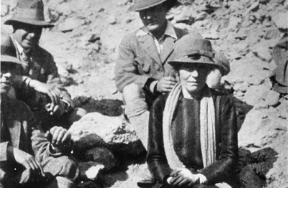Archaeologist
 Gertrude Bell frequently combined her desert travels with archaeological exploration and archaeology became increasingly important to her. She spent a great deal of time recording the sites she visited, with photography as well as drawings, plans and descriptions in her notebooks. She knew or worked with many of the leading archaeologists in the Middle East and was committed to preserving the heritage of Iraq. She spent time with Sir Leonard Woolley at the ancient site of Ur where they went through the finds together and decided what was to remain in Iraq and what was to be allowed to go to the British Museum in London.
Gertrude Bell frequently combined her desert travels with archaeological exploration and archaeology became increasingly important to her. She spent a great deal of time recording the sites she visited, with photography as well as drawings, plans and descriptions in her notebooks. She knew or worked with many of the leading archaeologists in the Middle East and was committed to preserving the heritage of Iraq. She spent time with Sir Leonard Woolley at the ancient site of Ur where they went through the finds together and decided what was to remain in Iraq and what was to be allowed to go to the British Museum in London.
Gertrude's first love remained archaeology and, as Honorary Director of Antiquities in Iraq, she established the Iraq Museum in Baghdad and wrote the Antiquities legislation for Iraq. Gertrude took important photographs during seven months based in Jerusalem in 1900 (Album A). Her 1905 expedition through the Syrian Desert to Asia Minor was published as The Desert and the Sown and as short papers in the journal Revue Archéologique. Her study, in 1907, with Sir William Ramsay of Binbirkilise at the Karadağ mountain and sites in central Anatolia was published as The Thousand and One Churches and remains a standard work on early Byzantine architecture in Anatolia. Her research on the churches and monasteries in the Tur Abdin in Eastern Turkey was published in Amida, a volume by van Berchem and Strzygowski (1910) and an article in the journal Zeitschrift für Geschichte der Architektur (1913). In 1914, she published an important monograph on the Early Islamic Palace and Mosque at Ukhaidir (Iraq).
In the picture: Gertrude Bell, Leonard Wooley and other European archaeologists at Ur (Iraq, 1914-1926).
Click on the photograph to know more.